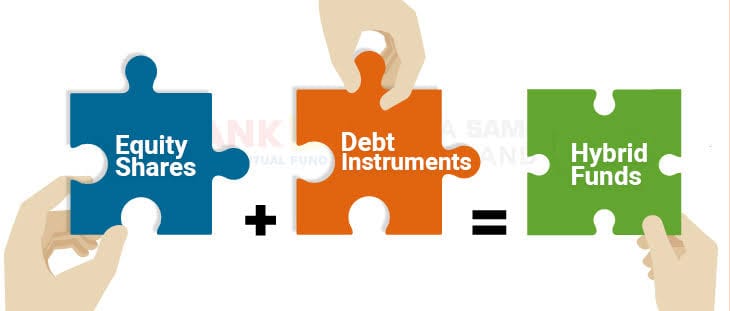Mutual Funds that combine both, debt and equity classes in a single fund are called hybrid funds. Most hybrid funds invest in debt and equity, however, others allocate their portfolio to other asset classes including gold, foreign equities, etc. Equities, debt, and commodities are the three sectors that make up hybrid fund investments. Hybrid Funds are the type of investment instrument that aims to assist a plan in reaching its investment objective by combining debt and equity.
In addition to promoting portfolio diversity, hybrid funds also assist in reducing risk in an unstable market. Putting money into any financial instruments, particularly, in equities is extremely risky. With their steady investing approach and respectable returns, these funds let you diversify your portfolio. Thank you to hybrid funds, you may have a diversified portfolio with only one fund. Both short-term and long-term financial goals might benefit from these funds since they aim to provide higher returns at lower risk.
Types of Hybrid Mutual Funds
Hybrid Funds are classified into various categories according to their asset allocation. Every hybrid fund targets a distinct investor base. The percentage of each asset class can vary and depends on the objective of the scheme and the fund manager’s strategy. Experts suggest investing in any mutual fund, whether it’s hybrid, debt or equity, an investor should invest only after considering and evaluating all the aspects with almost caution.
Balanced Hybrid Funds, Arbitrage Funds, Equity Savings Funds, Conservative Hybrid Funds, Aggressive Hybrid Funds, Multi-Asset Allocation Funds, and Dynamic Allocation Funds are various forms of Hybrid Funds with different mix of debt and equity. Among these, Multi-Asset Allocation Funds, invest a minimum of 10% in three asset classes. Other than Debt and Equity, these include other asset classes, such as Real Estate Investment Trusts (REITs), gold, etc. Investing in multi-asset funds exposes you to at least three different asset classes.
Advantages and Disadvantages
Hybrid funds come with their own advantages and disadvantages, depending on investors’ aptitude and investment patterns.
Let’s explore the advantages of hybrid funds:
Diversification Across Asset Classes: Hybrid mutual funds diversify their investments by investing in more than one asset class. Diversifying across different asset classes can help investors reduce risk and potentially benefit from different market conditions.
Balancing Risk and Return: Unlike pure equity funds, hybrid funds offer stability by including stable assets like debt. Investors can strike a balance between risk and return, making these funds suitable for those seeking moderate risk exposures.
Single Fund, Multiple Asset Classes: Instead of investing in separate funds for different asset classes, hybrid funds allow investors to access multiple asset types within a single product. This convenience simplifies portfolio management.
Customizable Investment: Depending on an investor’s risk tolerance and goals, hybrid funds can be tailored to meet specific needs. The allocation to equity, debt, and other assets can be adjusted based on individual preferences.
Tax Efficiency: Some hybrid funds benefit from favourable tax treatment applicable to equity-oriented schemes. Investors can potentially optimize tax liability while maintaining a diversified portfolio.
Hybrid funds provide a balanced approach, combining the best of different asset groups.
Let’s explore the disadvantages of hybrid funds:
Complexity and Compliance: The accounting, operational, and valuation requirements for hybrid funds can be quite complex. Regulatory and compliance issues arise due to the unique aspects of hybrid funds, such as investment allocations and conflicts of interest. Establishing and running these funds may incur higher costs compared to more straightforward fund structures.
Customization: Hybrid funds are highly customizable that appeal to some investors but not all. Investors accustomed to traditional hedge or private equity funds may find it challenging to categorize hybrid funds within their allocation strategy.
Performance Variation: Hybrid funds may not deliver high returns during market rallies because they are less volatile than pure equity funds. Their performance depends on the asset allocation mix, which can vary significantly across different hybrid funds.
Expense Ratios: Hybrid funds tend to have higher expense ratios than pure debt funds because of their dual exposure to equity and debt securities.
While hybrid funds offer a balanced approach, investors should carefully consider these disadvantages before investing.
Right Way!
Whether you are an ace investor or a new one, investing is risky at every level. The same is true with mutual funds. It does not matter what form of investing you do, it can’t be risk free or offer guaranteed returns. There are always some advantages and disadvantages associated with investing them. Investing without having a proper understanding might sabotage your investment potential return and portfolio. Moreover, it might also be a misfit to your portfolio if not invested considering various aspects of investing.
Investors in hybrid mutual funds have access to both debt and equity within a single fund. Depending on the fund in your portfolio, your investments might make a healthy profit because the hybrid fund provides varied investment options inside a single fund. One of the biggest benefits of a hybrid fund is its capacity to provide clients with automated asset allocation and rebalancing. Buying a single fund is preferable to buying two or more since it will improve your portfolio and return over time.



